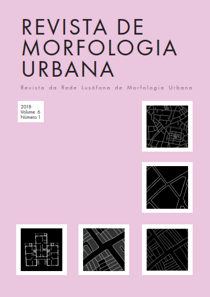Abstract
This paper aims at identifying which configurational morphological attributes have stronger correlation with co-presence in the socio-spatial context of two dispersed residential allotments in Santa Maria (RS), Brazil. Co-presence is the group of people who are together in a given space. The methodology consists of: i) axial and segment analysis of the study area with different radii; ii) measurement of co-presence levels categorized as ‘moving pedestrians’ and ‘stationary pedestrians; and iii) calculation of the Pearson correlation coefficients between co-presence and syntactic measures. It is based on the following question: how does the urban form explain the social appropriation of open spaces in dispersed settlements? The results showed that, although the two neighborhoods have different co-presence patterns, the measures of ‘integration’ and ‘choice’ have the strongest positive correlations with the number of pedestrians. The types of analysis and radius influenced the strength of the correlations: segment angular analysis with metric radius was more efficient for the largest number of categories of co-presence when these were not composed essentially by natural movement. In general, larger radii applied to local measurements generated the strongest correlations: R1000m for angular analysis, and R5 for axial analysis.
References
ADESM, Agência de Desenvolvimento de Santa Maria (2016) ‘Santa Maria em dados’ (santamariaemdados.com.br/sociedade/8-6-laz
er-e-esporte) consultado em 13 Julho de 2016.
Al-Sayed, K., Turner, A., Hillier, B.; Iida, S. e Penn, A. (2014) Space syntax methodology (UCL, Londres).
Arrais, J. de S. S. (2015) ‘Os espaços públicos em áreas centrais: configuração, vitalidade e infraestrutura ociosa no centro antigo de Goiânia’, Tese de Mestrado não publicada, Universidade de Brasília, Brasil.
Braga, A. da C. (2003) ‘Morfologia, transformação e co-presença em centros urbanos: o caso do Centro do Rio de Janeiro/RJ’, Tese de Mestrado não publicada, Universidade Federal do Rio Grande do Sul, Brasil.
Catalão, I. (2015) ‘Dispersão urbana: apontamentos para um debate’, Cidades 12, 250-77.
Dancey, C. e Reidy, J. (2006) Estatística sem matemática para psicologia: usando SPSS para Windows (Artmed, Porto Alegre).
Gehl, J. (2013) Cidades para pessoas (Perspectiva, São Paulo).
Grannis, R. (1998) ‘The importance of trivial streets: residential streets and residential segregation’, American Journal of Sociology 103, 1530-64.
Hillier, B. (2007) Space is the machine: a configurational theory of architecture (http://spaceisthemachine.com) consultado em 13 Julho de 2016.
Hillier, B. e Hanson, J. (1984) The social logic of space (Cambridge University Press, Cambridge).
Hillier, B. e Iida, S. (2005) ‘Network effects and psychological effects: a theory of urban movement’, 5th International Space Syntax Symposium, Delft, 13 a 17 de Junho.
Hillier, B. e Vaughan, L. (2007) ‘The city as one thing’, Progress in Planning 67, 199-294.
Hillier, B., Burdett, R., Peponis, J. e Penn, A. (1987) ‘Creating life: or, does architecture determine anything?’, Architecture et Comportement / Architecture and Behaviour 3, 233-50.
Hillier, B., Penn, A., Hanson, J., Grajewski, T. e Xu, J. (1993) ‘Natural movement: or, configuration and attraction in urban pedestrian movement’, Environment and Planning B 20, 29-66.
Holanda, F. (2002) O espaço de exceção (Universidade de Brasília, Brasília).
IBGE (2014) ‘Estimativas da população dos municípios brasileiros com data de referência em 1º de julho de 2014’ (www.ibge.gov.br/home/presidencia/noticias/pdf/analise_estimativas_2014.pdf) consultado em 27 Maio de 2017.
IBGE (2016) ‘Sinopse por setores – Censo 2010’ (www.censo2010.ibge.gov.br/sinopseporsetores)consultado em 13 Julho de 2016.
Krafta, R. (1997) ‘Urban configurational complexity: conceptualization and measurement’, 1st International Space Syntax Symposium, Londres, 15 a 18 de Abril.
Netto, V. M., Vargas, J. C. e Saboya, R. T. de (2012) ‘(Buscando) Os efeitos sociais da morfologia arquitetônica’, Urbe 4, 261-82.
Penn, A. (2001) ‘Space syntax and spatial cognition: or, why the axial line?’, 3rd International Space Syntax Symposium, Atlanta, 7 a 11 de Maio.
Reis, N. G. (2006) Notas sobre urbanização dispersa e novas formas de tecido urbano (Via das Artes, São Paulo).
Reis, N. G. e Bentes, J. C. da G. (2016) ‘Urbanização dispersa e novas formas de tecido urbano: estudos, diálogos e desafios’, IV Encontro da Associação Nacional de Pesquisa e Pós-graduação em Arquitetura e Urbanismo, Porto Alegre, 25 a 29 de Julho.
Turner, A. (2001) ‘Angular Analysis’, 3rd International Space Syntax Symposium, Atlanta, 7 a 11 de Maio.
Vaughan, L. e Grajewski, T. (2001) Space syntax observation manual (http://www.neolokator.cz /wp-content/uploads/2017/04/Observation_man
ual.pdf) consultado em 10 Janeiro de 2018.
Zampieri, F. L. L. (2012) ‘O fenômeno social do movimento de pedestres em centros urbanos’, Tese de Doutorado não publicada, Universidade Federal do Rio Grande do Sul, Brasil.
Zukin, S. (1995) The culture of cities (Blackwell, Cambridge).
Os direitos autorais permanecem com os autores, que autorizam a Revista de Morfologia Urbana a publicar o artigo sob uma licença Creative Commons Atribuição (CC-By).


